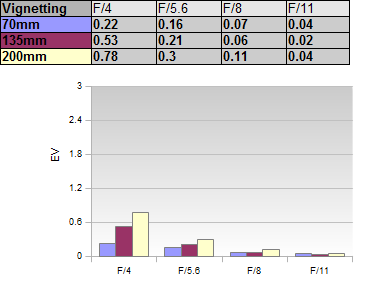|
Sony FE 70-200mm f/4 G OSS (SEL70200G) - Review / Test Report - Analysis |
|
Lens Reviews -
Sony Alpha (Full Format)
|
|
Page 2 of 2

Distortion
The Sony lens has a decent distortion characteristic. At 70mm it shows a medium amount of barrel distortion (1.1%) changing to medium pincushion distortions in the mid-range to long end. This is similar to its DSLR counterparts. Unsurprisingly, this can be also fully compensated when activating digital auto-correction.
If you move your mouse cursor over the image you can switch to the corresponding auto-corrected results (there may be a short delay).
Vignetting
At fully open aperture, the falloff varies between 1.1EV (wide-end) and 1.5EV (long end). Such a light falloff is usually visible but within the full format scope, it is also rather typical. Stopping down to f/5.6 resolves most of the issue and it's irrelevant from f/8 onward.
 With activated vignetting correction the light falloff decreases significantly, of course. It is basically negligible across all settings except at fully open aperture at and beyond 135mm where you may see traces of vignetting in certain scenes.
With activated vignetting correction the light falloff decreases significantly, of course. It is basically negligible across all settings except at fully open aperture at and beyond 135mm where you may see traces of vignetting in certain scenes.

MTF (resolution)
The resolution characteristic is mostly impressive. The center resolution is best at 70mm - it is excellent straight from f/4 and all the way up to f/11. The borders are generally very good whereas the corners are slightly weaker at f/4 but catch up from f/5.6 onward. The sweat spot of the lens is in the middle range. The center is marginally softer but the quality in the outer image region is much better. The lens is even capable of delivering excellent results across the image field at f/8 which is really rare especially for a zoom lens. There's a slight performance penalty at 200mm. The center is still very good to excellent followed by good to very good borders. However, the corners are soft at max. aperture. Stopping down to f/5.6 boosts the corners to towards the quality of the borders again. The field curvature is generally low.
The centering quality of the tested sample was mediocre.
Please note that the MTF results are not directly comparable across the different systems!
Below is a simplified summary of the formal findings. The chart shows line widths per picture height (LW/PH) which can be taken as a measure for sharpness.
If you want to know more about the MTF50 figures you may check out the corresponding Imatest Explanations
Chromatic Aberrations (CAs)
Lateral CAs can be auto-corrected either by the camera or via Sony's RAW converter. This is a lossless operation so it's a good idea to take advantage of it. However, the Sony lens is also very well corrected with an average CA pixel width of 1px or less at the image borders.

Bokeh
The Sony 70-200mm f/4 G OSS is comparatively slow for a professional tele-zoom lens. Nonetheless it is easily possible to achieve a shallow depth-of-field so the quality of the bokeh (out-of-focus blur) is an important criteria. The Sony lens does a good job here. Out-of-focus highlights are fairly evenly rendered although you may spot a slight nervousness in the inner highlight zone. The circular disc shape remains intact till f/5.6. At 8 you can spot marginal traces of the more edgy aperture shape.
 The rendition in the critical focus transition zone is very silky in the foreground. The background is also good but slightly less perfect.
The rendition in the critical focus transition zone is very silky in the foreground. The background is also good but slightly less perfect.

VerdictThe Sony FE 70-200mm f/4 G OSS is, undoubtedly, a high quality with just a few weaknesses. The resolution is generally on a very high level except at 200mm @ f/4 where the corners are too soft. Lateral CAs are well corrected and help to keep a high sharpness perception. The slight distortions are about average for a lens in this class. There's some visible light falloff at f/4 but the issue is mostly gone from f/5.6 onward. Many users will probably prefer to activate the auto-correction feature in the camera or RAW converter so the minor flaws in the secondary characteristics are taken care of anyway. This isn't applicable for the bokeh though but it is of pretty good quality in terms of highlight and blur rendition anyway. Bokeh fringing isn't relevant on a lens with a max. aperture of f/4.
The Sony lens is not only a looker but the mechanical quality is also truly impressive. It feels exceptionally solid and the control rings feel silky smooth. The weather sealing as well as the supplied tripod mount are also a nice bonus. Unfortunately it is a bit hard to comment on the AF potential. The A7R used for testing is slow in this respect but that's a camera issue. However, it's realistic to state that the system performance will remain inferior to DSLRs in the foreseeable future.
However, as already mentioned in the introduction you shouldn't really pair this lens with the Sony A7R anyway. The A7R creates rather massive shutter vibrations that are a game spoilers when using tele-lenses - even with activated OSS. However, the A7 and A7s should be able to exploit the really high potential of the Sony FE 70-200mm f/4 G OSS. Therefore highly recommended.
|